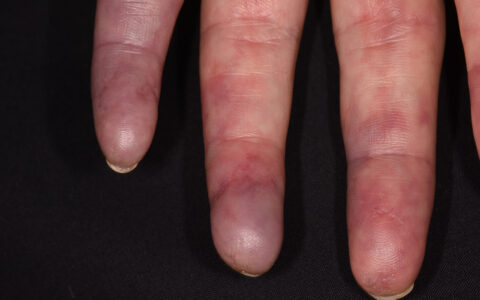Breakthrough drug treatments are rare and celebrated in the ongoing search for effective non-glucocorticoid treatments for autoimmune disease.
Rheumatologists recently took a step forward with avacopan, made available for treatment of granulomatosis with polyangiitis (formerly Wegener’s granulomatosis) or microscopic polyangiitis. These rare but aggressive forms of systemic vasculitis are collectively known as antineutrophil cytoplasmic antibody (ANCA)-associated vasculitis, or AAV.
Vanderbilt University Medical Center rheumatologist Jason Springer, M.D., who served as a site principal investigator for the phase 3 ADVOCATE study on avacopan, now prescribes the therapy for new-onset patients and plans on expanding into a larger pool of patients undergoing flares after remission.
“The pathway to this line of treatment had its origins in mouse studies in 2007 that demonstrated the importance of [complement factor] C5 in the pathogenesis of AAV,” Springer said. “It’s exciting to see the quick development of this drug and to be able to offer patients any opportunity I can to effectively treat their flares and reduce the steroid risks.”
Glucocorticoid Conundrum
Steroids have been a lifesaver, as well as a necessary evil, as one of the few therapies available to treat vasculitis until cyclophosphamide came along in the 1970s.
“Before that time, a vasculitis diagnosis was almost universally fatal. It meant you had around five to 12 months to live,” Springer said. “Then, cyclophosphamide, in combination with steroids, was discovered to put patients in remission, changing the landscape of the diseases from uniformly fatal to chronic. However, patients still dealt with significant drug-related side effects.”
When the disease flares with its hallmark blood vessel inflammation, steroids come to the rescue quickly. However, they work like a shotgun, Springer explained, broadly suppressing the activity of inflammatory cells such as lymphocytes and preventing neutrophils from degranulating.
“We produce glucocorticoids as a natural part of the immune system, but of course, when large quantities of steroids are by necessity marshaled to suppress a flare, steroid-related side effects are common. The side effects are in proportion to the dosage, duration, and individual responses.”
Rifle Versus Shotgun
Avacopan may help mitigate these consequences by working early in the innate immune response, inhibiting C5a receptors on inflammatory cells – predominantly leukocytes – before inflammation has the chance to proliferate.
C5a is a strong chemoattractant involved in inflammatory cell recruitment as part of the complement cascade. This cascade is triggered by autoimmunity to attack and penetrate microbial membranes. When C5a attaches to its receptor, it activates neutrophils, which then cause inflammatory destruction to tissues.
“Glucocorticoids are like a shotgun response, whereas avacopan is more like a rifle that targets one mechanism with the goal of avoiding collateral damage,” Springer said.
“Glucocorticoids are like a shotgun response, whereas avacopan is more like a rifle that targets one mechanism with the goal of avoiding collateral damage.”
ADVOCATE Gave the Green Light
ADVOCATE was a phase 3 randomized, double-blinded, controlled trial that enrolled 330 patients with new onset or relapsing AAV. Most had severe disease, and many were enrolled by a treating nephrologist for kidney disease.
The study group received twice-daily avacopan and the control group received a standard course of 20-week oral prednisone taper. The study arm allowed for some short-term glucocorticoid use, but study participants were tapered off glucocorticoids within a few days.
Avacopan was found to be non-inferior to prednisone taper with respect to remission at week 26. However, it was superior to prednisone taper with respect to sustained remission at week 52.
A post-hoc analysis also found a 75.6 percent incidence rate of infection in patients taking prednisone versus a 68.1 percent infection rate in the avacopan study group, in which patients also developed fewer serious infections or similar adverse events.
“With avacopan established as non-inferior or better, with lower infection rates, the ability to significantly reduce the burden of glucocorticoids is a major milestone in improving patient care,” Springer said.
“The ability to significantly reduce the burden of glucocorticoids is a major milestone in improving patient care.”
Reducing Steroid Use
Springer is not ready to completely replace glucocorticoids, but he emphasizes that avacopan provides an opportunity to significantly reduce the burden of these drugs. And he doesn’t rule out the possibility of a complete transition off steroids.
“Some studies have included glucocorticoid-free arms,” Springer said. “The outcomes were pretty good, particularly in terms of kidney function preservation, one of the chief concerns with flares.”





